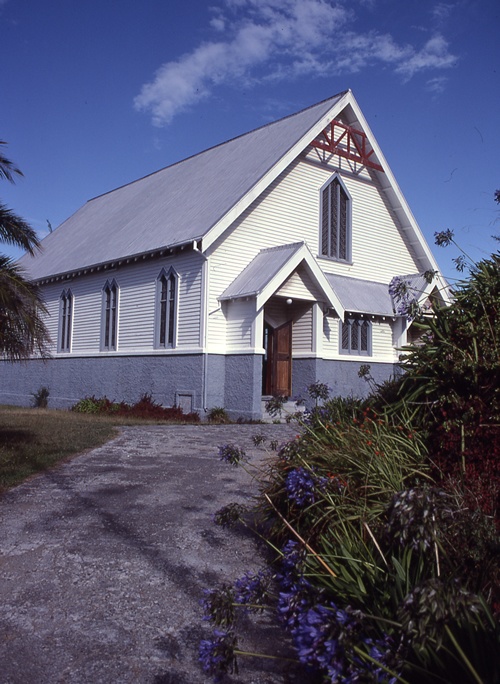
Tikitiki church war memorial including details from the interior and the memorial to Āpirana Ngata.
St Mary's church
St Mary’s church in Tikitiki serves as a memorial to the Māori men from the East Coast between Paritū (south of Gisborne) and Tarakeha/Torere (east of Ōpōtiki) who fought and died in the First World War. St Mary’s was built in the 1920s at the instigation of Ngāti Porou leader Āpirana Ngata. An early example of Ngata’s efforts to revive traditional Māori arts and crafts, it is regarded as one of the most beautiful Māori churches in New Zealand.
Building and design
The building of the church between 1924 and 1926 involved many members of Ngāti Porou, including elders and schoolchildren. St Mary’s spectacular interior showcases Māori carvings, kowhaiwhai designs and tukutuku panels. Hone Ngatoto, a local tohunga whakairo (master carver), was responsible for much of the carving work. Te Arawa contributed the pulpit and a number of smaller carvings, and iwi from the Waikato region gave the communion rail. Ngata supervised the weaving of tukutuku and the painting of kowhaiwhai designs on the rafters.
A striking stained-glass window depicts Second Lieutenant Henare Kohere and Captain Pekama Kaa kneeling at the feet of Christ on the Cross. Both men were killed in the war. The church also pays tribute to Taumata-a-Kura, a captive of Ngāpuhi who introduced Christianity to Waiapu upon his return to the area in 1834. St Mary’s church was built on the site of Pukemaire pā, where a battle was fought in 1866 between Christian and Pai Marire (‘Hauhau’) factions of Ngāti Porou. Veterans of the New Zealand Wars were honoured guests at the consecration of St Mary’s.
Consecration
St Mary’s church was consecrated on 16 February 1926. Up to 5000 people, including chiefs from all over the North Island, gathered at Tikitiki for the occasion. Ngata, Prime Minister Gordon Coates, Governor-General Sir Charles Fergusson, Cabinet minister Sir Maui Pomare and Māori health advocate and former Cabinet Minister Peter Buck all attended the gathering. The Right Reverend William Walmsley Sedgwick, Bishop of Waiapu, conducted the consecration ceremony. The hymns were chosen from among those most popular with Māori soldiers during the war.
Addressing the crowd, Prime Minister Coates stated that he hoped that Māori would take note of the day, as it showed Pākehā what they owed to Māori and would strengthen the bond between Māori and Pākehā. ‘You only have to look [at the memorial] on the hill’, said Coates, ‘and remember that when the Empire was in trouble New Zealanders offered their services as men, Maori and Pakeha, and as Maori and Pakeha they fell side by side.’
Unveiling
Later that day, Sir Charles Fergusson unveiled the statue of a soldier on the hillside above the church. Like the church, it commemorates local Māori men who served in the war. The Prime Minister then unveiled the church’s roll of honour. It reads: ‘He tohu aroha ki nga hoia Maori. O Horouta, o Takitimu. Te Paritu ki Tarakeha. 1914. 1918. I uru ki Te Pakanga Nui.’ Translation: ‘A memorial for the Māori soldiers of the Horouta and Takitimu waka, from Paritu to Tarakeha, who fought in the Great War, 1914–1918.’ The board lists each soldier’s name, rank, place and date of death, and serial number. The names of local Second World War servicemen have been added to the board.
After Ngata’s death in 1950, local people erected a memorial to him beside the church. The obelisk was unveiled on 13 July 1952 by Prime Minister Sidney Holland, who praised Ngata’s ‘adventurous leadership’ of his people.
In 2002, Ngāti Porou and the former New Zealand Historic Places Trust jointly undertook conservation work on the church’s carvings, ornate windows and decorative panels. The Trust has registered St Mary’s as a Category 1 Historic Place.
St Mary’s continues to have great significance to Ngāti Porou people, and is often referred to as their cathedral.
Further information
- ‘Great Maori Gathering’, Poverty Bay Herald, 17 February 1926, p. 14
- ‘Two Great Traditions’, Evening Post, 27 February 1926, p. 10
- ‘Maori World Shows Gloom at Loss of Sir Apirana’, Te Ao Hou, Spring 1952, pp. 3–6
- Richard Pamatatau, ‘East Coast buildings give life to the supreme sacrifice’, Heritage New Zealand, Autumn 2004, no. 92, pp. 22–6
- Peter Quinn and Kennedy Warne, ‘Lest we forget: preserving a historic church’, New Zealand Geographic, September/October 2002, no. 59, pp. 22–34
- Images of St Mary's Church on Te Ara











Community contributions